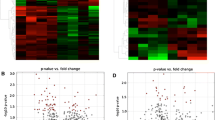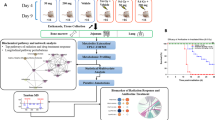Abstract
Purpose
Biomarkers serve a number of purposes during drug development including defining the natural history of injury/disease, serving as a secondary endpoint or trigger for intervention, and/or aiding in the selection of an effective dose in humans. BIO 300 is a patent-protected pharmaceutical formulation of nanoparticles of synthetic genistein being developed by Humanetics Corporation. The primary goal of this metabolomic discovery experiment was to identify biomarkers that correlate with radiation-induced lung injury and BIO 300 efficacy for mitigating tissue damage based upon the primary endpoint of survival.
Methods
High-throughput targeted metabolomics of lung tissue from male C57L/J mice exposed to 12.5 Gy whole thorax lung irradiation, treated daily with 400 mg/kg BIO 300 for either 2 weeks or 6 weeks starting 24 h post radiation exposure, were assayed at 180 d post-radiation to identify potential biomarkers.
Results
A panel of lung metabolites that are responsive to radiation and able to distinguish an efficacious treatment schedule of BIO 300 from a non-efficacious treatment schedule in terms of 180 d survival were identified.
Conclusions
These metabolites represent potential biomarkers that could be further validated for use in drug development of BIO 300 and in the translation of dose from animal to human.







Similar content being viewed by others
Abbreviations
- ARS:
-
Acute radiation syndrome
- CID:
-
Collision-induced dissociation
- DEARE:
-
Delayed effects of acute radiation exposure
- FDA:
-
Federal Drug Administration
- FDR:
-
False discovery rate
- FIA:
-
Flow injection analysis
- H&E:
-
Hematoxylin and eosin
- HDMSE :
-
High definition mass spectrometry
- HPLC:
-
High-performance liquid chromatography
- LC:
-
Liquid chromatography
- LD:
-
Lethal dose
- MCM:
-
Medical countermeasure
- MRM:
-
Multiple reaction monitoring
- NMDA:
-
N-methyl-D-aspartate
- PC:
-
Glycerophosphatidylcholine
- PCa:
-
Diacyl glycerophosphatidylcholine
- PCA:
-
Principal component analysis
- PCe:
-
Ether glycerophosphatidylcholine
- PCho:
-
Phosphocholine
- PE:
-
Glycerophosphoethanolamine
- PLS-DA:
-
Partial least squares-discriminate analysis
- PUFA:
-
Polyunsaturated fatty acid
- sem:
-
Standard error of the mean
- SFA:
-
Saturated fatty acid
- SM:
-
Sphingomyelin
- TIC:
-
Total ion chromatogram
- UPLC:
-
Ultra performance liquid chromatography
- XIC:
-
Extracted ion chromatogram
- WTLI:
-
Whole thorax lung irradiation
References
Dorr H, Meineke V. Acute radiation syndrome caused by accidental radiation exposure - therapeutic principles. BMC med. 2011;9:126.
MacVittie TJ, Farese AM, Jackson W III. The hematopoietic syndrome of the acute radiation syndrome in rhesus macaques: a systematic review of the lethal dose response relationship. Health Phys. 2015;109(5):342–66.
Van Dyk J, Keane TJ, Kan S, Rider WD, Fryer CJ. Radiation pneumonitis following large single dose irradiation: a re-evaluation based on absolute dose to lung. Int J Radiat Oncol Biol Phys. 1981;7(4):461–7.
Mah K, Van Dyk J. Quantitative measurement of changes in human lung density following irradiation. Radiother Oncol. 1988;11(2):169–79.
Day RM, Barshishat-Kupper M, Mog SR, McCart EA, Prasanna PG, Davis TA, et al. Genistein protects against biomarkers of delayed lung sequelae in mice surviving high-dose total body irradiation. J Radiat res. 2008;49(4):361–72.
Calveley VL, Jelveh S, Langan A, Mahmood J, Yeung IW, Van Dyk J, et al. Genistein can mitigate the effect of radiation on rat lung tissue. Radiat res. 2010;173(5):602–11.
Yang Z, Kulkarni K, Zhu W, Hu M. Bioavailability and pharmacokinetics of genistein: mechanistic studies on its ADME. Anti Cancer Agents med Chem. 2012;12(10):1264–80.
Ha CT, Li XH, Fu D, Xiao M, Landauer MR. Genistein nanoparticles protect mouse hematopoietic system and prevent proinflammatory factors after gamma irradiation. Radiat res. 2013;180(3):316–25.
Jackson IL, Zodda A, Gurung G, Pavlovic R, Kaytor MD, Kuskowski MA, Vujaskovic Z. BIO 300, a nanosuspension of Genistein, mitigates pneumonitis/fibrosis following high dose radiation exposure in the C57L/J murine model. Br J Pharmacol 2017. (in review).
Jackson IL, Xu P, Hadley C, Katz BP, McGurk R, Down JD, et al. A preclinical rodent model of radiation-induced lung injury for medical countermeasure screening in accordance with the FDA animal rule. Health Phys. 2012;103(4):463–73.
Product development under the animal rule: Guidance for industry. U.S. Department of Health and Human Services, Food and Drug Administration (FDA), Center for Drug Evaluation and Research (CDER), Center for Biologics Evaluation and Research (CBER). 2015. Available from: https://www.fda.gov/downloads/drugs/guidances/ucm399217.pdf.
Guidance for industry and FDA staff: Qualification process for drug development tools. U.S. Department of Health and Human Services, Food and Drug Administration (FDA), Center for Drug Evaluation and Research (CDER), Center for Biologics Evaluation and Research (CBER). 2014. Available from: https://www.fda.gov/downloads/drugs/guidances/ucm230597.pdf.
Biomarkers Definitions Working G. Biomarkers and surrogate endpoints: preferred definitions and conceptual framework. Clin Pharmacol Ther. 2001;69(3):89–95.
Jones JW, Carter CL, Li F, Yu J, Pierzchalski K, Jackson IL, et al. Ultraperformance convergence chromatography-high resolution tandem mass spectrometry for lipid biomarker profiling and identification. Biomed Chromatogr. 2017;31(3):e3822. doi:10.1002/bmc.3822.
Tyburski JB, Patterson AD, Krausz KW, Slavik J, Fornace AJ Jr, Gonzalez FJ, et al. Radiation metabolomics. 1. Identification of minimally invasive urine biomarkers for gamma-radiation exposure in mice. Radiat res. 2008;170(1):1–14.
Ossetrova NI, Sandgren DJ, Blakely WF. Protein biomarkers for enhancement of radiation dose and injury assessment in nonhuman primate total-body irradiation model. Radiat Prot Dosim. 2014;159(1–4):61–76.
Jones JW, Scott AJ, Tudor G, Xu PT, Jackson IL, Vujaskovic Z, et al. Identification and quantitation of biomarkers for radiation-induced injury via mass spectrometry. Health Phys. 2014;106(1):106–19.
Biomarkers Used as Outcomes in Development of FDA-Approved Therapeutics (October 2007–December 2015) [10/18/2016]. Available from: http://www.fda.gov/Drugs/DevelopmentApprovalProcess/DrugDevelopmentToolsQualificationProgram/ucm483052.htm.
Mukherjee D, Coates PJ, Lorimore SA, Wright EG. Responses to ionizing radiation mediated by inflammatory mechanisms. J Pathol. 2014;232(3):289–99.
Fleckenstein K, Zgonjanin L, Chen L, Rabbani Z, Jackson IL, Thrasher B, et al. Temporal onset of hypoxia and oxidative stress after pulmonary irradiation. Int J Radiat Oncol Biol Phys. 2007;68(1):196–204.
Carter CL, Jones JW, Farese AM, MacVittie TJ, Kane MA. Inflation-fixation method for Lipidomic mapping of lung biopsies by matrix assisted laser desorption/ionization-mass spectrometry imaging. Anal Chem. 2016;88(9):4788–94.
Xia J, Wishart DS. Using MetaboAnalyst 3.0 for Comprehensive Metabolomics Data Analysis. Curr Protoc Bioinformatics. 2016;55(14.10):1–14.
Castro-Perez J, Roddy TP, Nibbering NM, Shah V, McLaren DG, Previs S, et al. Localization of fatty acyl and double bond positions in phosphatidylcholines using a dual stage CID fragmentation coupled with ion mobility mass spectrometry. J am Soc Mass Spectrom. 2011;22(9):1552–67.
Lisa M, Cifkova E, Holcapek M. Lipidomic profiling of biological tissues using off-line two-dimensional high-performance liquid chromatography-mass spectrometry. J Chromatogr a. 2011;1218(31):5146–56.
Houjou T, Yamatani K, Nakanishi H, Imagawa M, Shimizu T, Taguchi R. Rapid and selective identification of molecular species in phosphatidylcholine and sphingomyelin by conditional neutral loss scanning and MS3. Rapid Commun Mass Spectrom. 2004;18(24):3123–30.
Pannkuk EL, Fornace AJ Jr, Laiakis EC. Metabolomic applications in radiation biodosimetry: exploring radiation effects through small molecules. Int J Radiat Biol. 2017;12:1–26.
Brunelli L, Caiola E, Marabese M, Broggini M, Pastorelli R. Comparative metabolomics profiling of isogenic KRAS wild type and mutant NSCLC cells in vitro and in vivo. Sci Report. 2016;6:28398.
Schnackenberg LK, Pence L, Vijay V, Moland CL, George N, Cao Z, et al. Early metabolomics changes in heart and plasma during chronic doxorubicin treatment in B6C3F1 mice. J Appl Toxicol. 2016;36(11):1486–95.
Qiu Y, Zhou B, Su M, Baxter S, Zheng X, Zhao X, et al. Mass spectrometry-based quantitative metabolomics revealed a distinct lipid profile in breast cancer patients. Int J Mol Sci. 2013;14(4):8047–61.
Conlon TM, Bartel J, Ballweg K, Gunter S, Prehn C, Krumsiek J, et al. Metabolomics screening identifies reduced L-carnitine to be associated with progressive emphysema. Clin Sci (Lond.). 2016;130(4):273–87.
Carter CL, Jones JW, Barrow K, Kieta K, Taylor-Howell C, Kearney S, et al. A MALDI-MSI approach to the characterization of radiation-induced lung injury and medical countermeasure development. Health Phys. 2015;109(5):466–78.
Wu G. Amino acids: metabolism, functions, and nutrition. Amino Acids. 2009;37(1):1–17.
Orlando GF, Wolf G, Engelmann M. Role of neuronal nitric oxide synthase in the regulation of the neuroendocrine stress response in rodents: insights from mutant mice. Amino Acids. 2008;35(1):17–27.
Wu G, Bazer FW, Davis TA, Kim SW, Li P, Marc Rhoads J, et al. Arginine metabolism and nutrition in growth, health and disease. Amino Acids. 2009;37(1):153–68.
Chen PE, Geballe MT, Stansfeld PJ, Johnston AR, Yuan H, Jacob AL, et al. Structural features of the glutamate binding site in recombinant NR1/NR2A N-methyl-D-aspartate receptors determined by site-directed mutagenesis and molecular modeling. Mol Pharmacol. 2005;67(5):1470–84.
Said SI, Berisha HI, Pakbaz H. Excitotoxicity in the lung: N-methyl-D-aspartate-induced, nitric oxide-dependent, pulmonary edema is attenuated by vasoactive intestinal peptide and by inhibitors of poly(ADP-ribose) polymerase. Proc Natl Acad Sci U S a. 1996;93(10):4688–92.
Li Y, Liu Y, Peng X, Liu W, Zhao F, Feng D, et al. NMDA receptor antagonist attenuates bleomycin-induced acute lung injury. PLoS One. 2015;10(5):e0125873.
da Cunha AA, Pauli V, Saciura VC, Pires MG, Constantino LC, de Souza B, et al. N-methyl-D-aspartate glutamate receptor blockade attenuates lung injury associated with experimental sepsis. Chest. 2010;137(2):297–302.
da Cunha AA, Nunes FB, Lunardelli A, Pauli V, Amaral RH, de Oliveira LM, et al. Treatment with N-methyl-D-aspartate receptor antagonist (MK-801) protects against oxidative stress in lipopolysaccharide-induced acute lung injury in the rat. Int Immunopharmacol. 2011;11(6):706–11.
Tang F, Yue S, Luo Z, Feng D, Wang M, Qian C, et al. Role of N-methyl-D-aspartate receptor in hyperoxia-induced lung injury. Pediatr Pulmonol. 2005;40(5):437–44.
Engelmann B, Brautigam C, Thiery J. Plasmalogen phospholipids as potential protectors against lipid peroxidation of low density lipoproteins. Biochem Biophys res Commun. 1994;204(3):1235–42.
Harwood JL. Lung surfactant. Prog Lipid res. 1987;26(3):211–56.
Griese M. Pulmonary surfactant in health and human lung diseases: state of the art. Eur Respir J. 1999;13(6):1455–76.
Finkelstein JN. Physiologic and toxicologic responses of alveolar type II cells. Toxicology. 1990;60(1–2):41–52.
Agrawal A, Kale RK. Radiation induced peroxidative damage: mechanism and significance. Indian J Exp Biol. 2001;39(4):291–309.
Catala A. Lipid peroxidation of membrane phospholipids generates hydroxy-alkenals and oxidized phospholipids active in physiological and/or pathological conditions. Chem Phys Lipids. 2009;157(1):1–11.
Braverman NE, Moser AB. Functions of plasmalogen lipids in health and disease. Biochim Biophys Acta. 2012;1822(9):1442–52.
Niaudet C, Bonnaud S, Guillonneau M, Gouard S, Gaugler MH, Dutoit S, et al. Plasma membrane reorganization links acid sphingomyelinase/ceramide to p38 MAPK pathways in endothelial cells apoptosis. Cell Signal. 2017;33:10–21.
Corre I, Guillonneau M, Paris F. Membrane signaling induced by high doses of ionizing radiation in the endothelial compartment. Relevance in radiation toxicity. Int J Mol Sci. 2013;14(11):22678–96.
Kolesnick R, Fuks Z. Radiation and ceramide-induced apoptosis. Oncogene. 2003;22(37):5897–906.
Author information
Authors and Affiliations
Corresponding author
Electronic supplementary material
ESM 1
(DOCX 2622 kb)
Rights and permissions
About this article
Cite this article
Jones, J.W., Jackson, I.L., Vujaskovic, Z. et al. Targeted Metabolomics Identifies Pharmacodynamic Biomarkers for BIO 300 Mitigation of Radiation-Induced Lung Injury. Pharm Res 34, 2698–2709 (2017). https://doi.org/10.1007/s11095-017-2200-9
Received:
Accepted:
Published:
Issue Date:
DOI: https://doi.org/10.1007/s11095-017-2200-9




